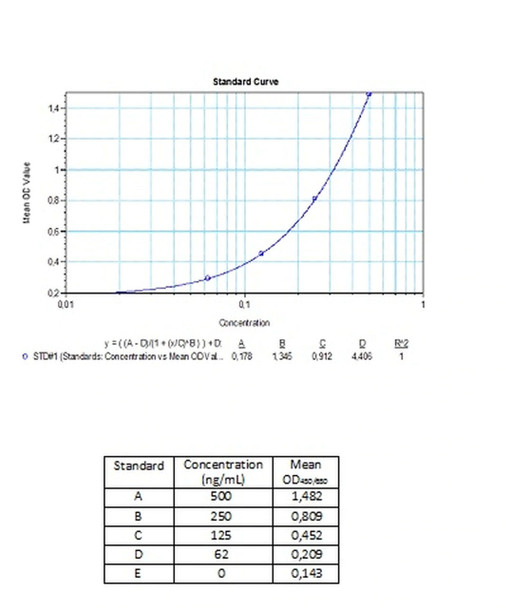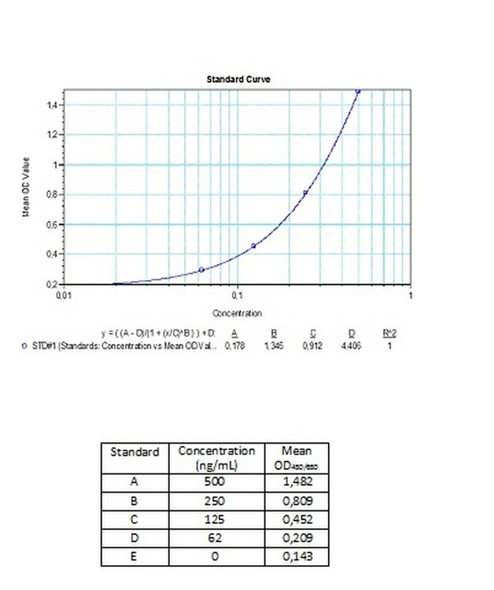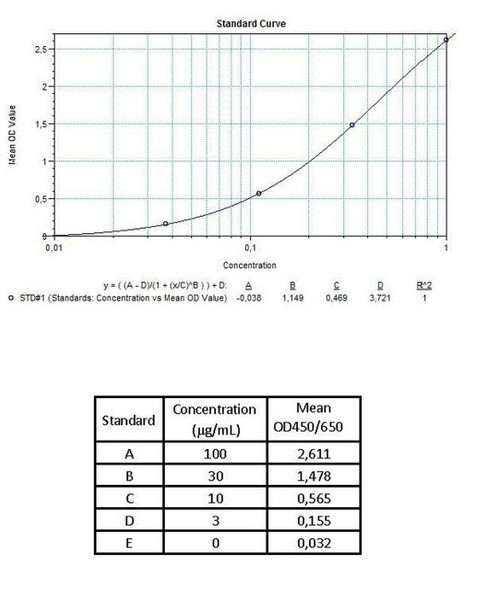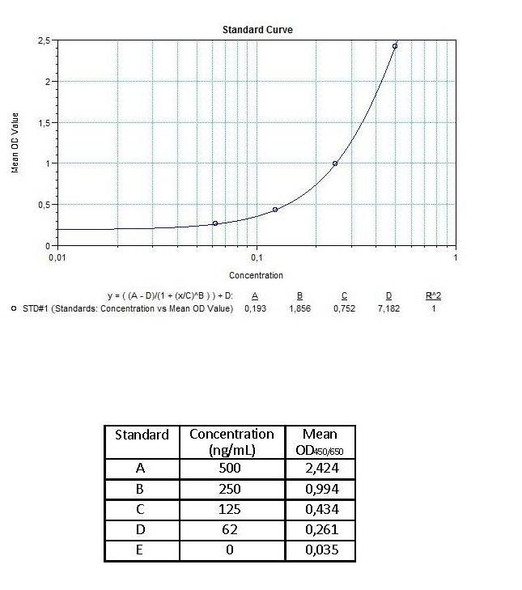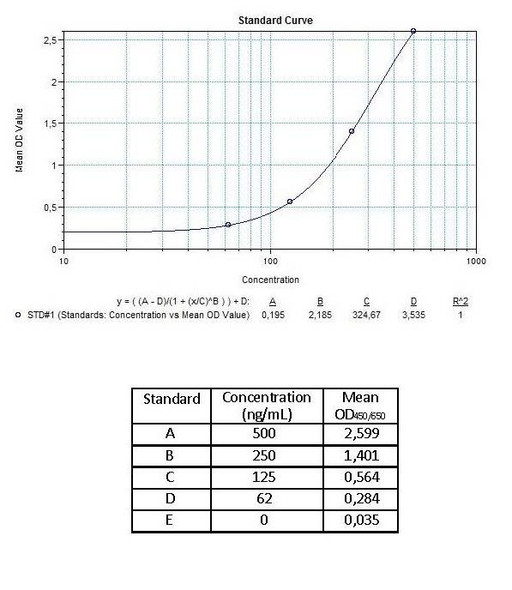Therapeutic Drug Monitoring
Anti-Bevacizumab (Avastin®)ADA Quantitative ELISA Kit
- SKU:
- HUMB00026
- Product Type:
- ELISA Kit
- ELISA Type:
- Biosimilar ELISA
- Biosimilar ELISA Type:
- Quantitative
- Applications:
- ELISA
- Reactivity:
- Human
- Analytes:
- Bevacizumab (Avastin®)
- Research Area:
- Anti-Cancer
- Research Area:
- Wet AMD
Description
Anti-Bevacizumab ADA Quantitative ELISA Kit
Enzyme-linked immunosorbent assay for the quantitative determination of antibodies to Bevacizumab in serum and plasma. The Assay Genie Antibody to Bevacizumab (Avastin®) ELISA Kit is intended for the quantitative determination of Bevacizumab anti-drug antibodies (ADA) in serum and plasma. As with all therapeutic proteins, there is a potential for immunogenicity. The Assay Genie Anti-Bevacizumab ELISA Kit can be used for monitoring anti-Bevacizumab antibodies in biological samples and is for research use only.
Anti-Bevacizumab (Avastin®) ADA Quantitative ELISA Kit test principle
The Assay Genie Antibody to Bevacizumab (Avastin®) ELISA is a double antigen sandwich assay for the determination of anti-bevacizumab antibodies in serum and plasma samples. During the first incubation period, the drug bevacizumab coated on the wall of the microtiter wells captures the antibodies to bevacizumab in patient serum and plasma samples. After washing away the unbound components from samples, a Peroxidase-labelled bevacizumab conjugate is added to each well and then incubated. After a second washing step, the bound enzymatic activity is detected by addition of tetramethylbenzidine (TMB) chromogen-substrate. Finally, the reaction is terminated with an acidic stop solution. The intensity of the reaction colour is proportional to the concentration of antibodies to bevacizumab in sample.
Anti-Bevacizumab (Avastin®) ADA Quantitative ELISA Product Information
| Information | Description |
Application | Free drug |
Required Volume (μl) | 10 |
Total Time (min) | 140 |
Sample Type | Serum, Plasma |
Number of Assays | 96 |
Detection Limit (ng/mL) | 31 (ng/mL) |
Spike Recovery (%) | 85-115% |
Shelf Life (year) | 1 |
Alternative Names | Anti-VEGF mAb |
Anti-Bevacizumab (Avastin®) ADA Quantitative ELISA - Key Information
Bevacizumab (Avastin®) mode of action
Bevacizumab (Avastin®) is a recombinant human IgG1:k monoclonal antibody specific for all human vascular endothelial growth factor-A (VEGF-A) isoforms. Bevacizumab carrries out anti-VEGF function by binding circulating VEGF, which in-turn inhibits the binding of VEGF to its cell surface receptors. This inhibition results in a decrease in microvascular growth of tumor blood vessels and therefore limits the blood supply to tumor tissues.
Bevacizumab (Avastin®) history
In 1997, the humanization of the murine anti-VEGF mAb was reported. Like its murine counterpart, bevacizumab binds to and neutralizes all human VEGF-A isoforms and bioactive proteolytic fragments, but not mouse or rat VEGF. However, bevacizumab was observed to inhibit the growth of human tumor cell lines in nude mice.
Studies have demonstrated that bevacizumab, in combination with chemotherapy, resulted in increased survival in patients with previously untreated metastatic colorectal cancer relative to chemotherapy alone, leading to FDA approval of the first anti-angiogenic agent. Anti-VEGF monoclonal antibodies and other VEGF inhibitors block the growth of several tumor cell lines in nude mice. Clinical trials with VEGF inhibitors in a variety of malignancies are ongoing. The pharmacokinetic properties of bevacizumab in several species have been previously described and are consistent with a typical humanized monoclonal antibody. In 1997, Phase I clinical trials with bevacizumab was initiated. These Phase I studies showed that the antibody as a single agent was relatively non-toxic and that adding it to standard chemotherapy regimens did not significantly exacerbate chemotherapy associated toxicities.
In 1998, several Phase II studies were initiated with bevacizumab in different tumor types, either as a single agent or in combination with chemotherapy. bevacizumab was combined with Standard first-line chemotherapy in metastatic colorectal cancer and stage IIIb/IV non-small cell lung cancer. The potential clinical utility of VEGF inhibition in oncology is not limited to solid tumors. There is growing evidence that VEGF and VEGF receptors are expressed by a variety of leukemias and other hematologic malignancies, suggesting that inhibition of VEGF or VEGFR signaling may have a role in the treatment of such conditions. Several clinical trials are currently testing these hypotheses. Although bevacizumab was generally well tolerated, but some serious and unusual toxicities were noted. Some open-label Phase I and II clinical trials had identified a number of adverse events, including thrombosis and bleeding as potential bevacizumab-related toxicities. In addition, most common adverse reactions are epistaxis, headache, hypertension, rhinitis, proteinuria, taste alteration, dry skin, rectal hemorrhage, lacrimation disorder, back pain and exfoliative dermatitis.
Bevacizumab (Avastin®) uses
The humanized anti-VEGF monoclonal antibody, bevacizumab, has been approved by the FDA as a first-line treatment for metastatic colorectal cancer in combination with chemotherapy. Furthermore, VEGF is implicated in intraocular neovascularization associated with diabetic retinopathy and age-related macular degeneration.
Bevacizumab (Avastin®) immunogenicity
As with all therapeutic proteins, there is a potential for immunogenicity. According to the manufacturer's product insert; the incidence of antibody development in patients receiving Avastin has not been adequately determined because the assay sensitivity was inadequate to reliably detect lower titers. Enzyme-linked immunosorbent assays (ELISAs) were performed on sera from approximately 500 patients treated with Avastin, primarily in combination with chemotherapy. High titer human anti-Avastin antibodies were not detected. Immunogenicity data are highly dependent on the sensitivity and specificity of the assay.
Additionally, the observed incidence of antibody positivity in an assay may be influenced by several factors, including sample handling, timing of sample collection, concomitant medications, and underlying disease. For these reasons, comparison of the incidence of antibodies to Avastin with the incidence of antibodies to other products may be misleading. The Assay Genie Antibody to Bevacizumab ELISA Kit can be used for monitoring anti-bevacizumab antibodies in biological samples and is for research use only.
Anti-Bevacizumab (Avastin®) ADA Quantitative ELISA Kit Contents
| Size | Kit Contents |
1x12x8 | Microtiter Plate Break apart strips. Microtiter plate with 12 rows each of 8 wells coated with reactant. |
7 x 0.3 mL | ATB Standards A-E, High Level Control, Low Level Control |
1 x 50 mL | Assay Buffer |
1 x 12 mL | Confirmation Reagent |
1 x 12 mL | Horse radish peroxidase-Conjugated Probe. Red coloured. Ready to use. Contains HRP-probe, stabilizer and preservatives. |
1 x 12 mL | TMB Substrate Solution |
1 x 12 mL | TMB Stop Solution |
2 x 1 | Adhesive Foil |
Anti-Bevacizumab (Avastin®) ADA Quantitative ELISA Protocol
| Steps | Protocol |
1 | QUANTITATIVE ELISA TEST FORMAT Wells |
2 | Cover the plate with adhesive foil. Briefly mix contents by gently shaking the plateIncubate 60 min at room temperature (18- 25°C). |
3 | Remove adhesive foil. Discard incubation solution. Wash plate 3 times each with 300µL of diluted. Wash Buffer. Remove excess solution by tapping the inverted plate on a paper towel. |
4 | Pipette 100 µL of ready-to use Peroxidase Conjugate into each well. |
5 | Cover the plate with adhesive foil. Incubate 60 min at room temperature (18- 25°C). |
6 | Remove adhesive foil. Discard incubation solution. Wash plate 3 times each with 300 µL of diluted Wash Buffer. Remove excess solution by tapping the inverted plate on a paper towel. |
7 | Pipette 100 µL of TMB Substrate Solution into each well. |
8 | Incubate 20 min (without adhesive foil) at room temperature (18-25°C) in the dark |
9 | Stop the substrate reaction by adding 100 µL of Stop Solution into each well. Briefly mix contents by gently shaking the plate. Colour changes from blue to yellow. |
10 | Measure optical density with a photometer at 450/650 nm within 30 min after pipetting of the Stop Solution. |
Trademarks
Avastin® is a registered trademark of Genentech, Inc.

